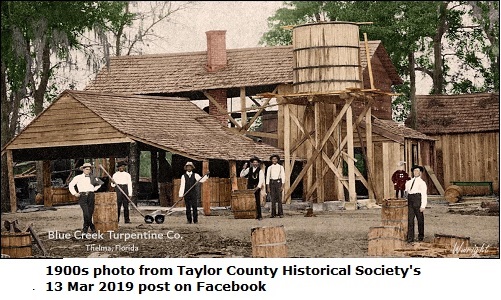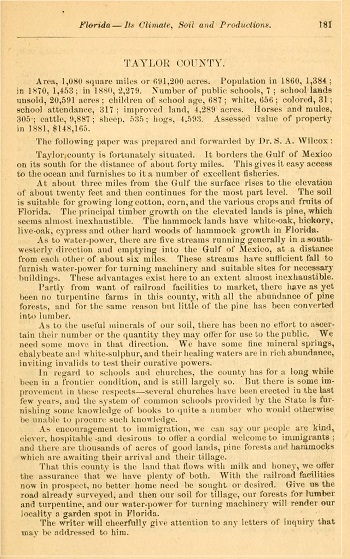
 Taylor
County FLGenWeb is a free genealogical site about the history
of the county. We hope you find helpful clues for your research of
Taylor county ancestors.
Taylor
County FLGenWeb is a free genealogical site about the history
of the county. We hope you find helpful clues for your research of
Taylor county ancestors.
Are you familiar with the area? Do you have a family tree connection to the area? Volunteers are always needed! Please consider contributing your pieces of Taylor County family history. Corrections, updates, and additions to this site are always welcome.
County Coordinator: YOU? Taylor County FLGenWeb is Available for Adoption. If you are interested, please contact the State Coordinator at FLGenWeb.
Temporary County Coordinator: Norma Hass
Taylor County became the 34th county in Florida on 23 Dec 1856. It was named in honor of President Zachary Taylor. The county was carved out of Madison County. Perry is the county seat. (Perry was originally called Rosehead.)
 Area, 1,080 square miles or 691,200 acres. Population in
1860, 1,384; in 1870, 1,453; in 1880, 2,279. Number of public schools,
7; school lands unsold, 20,591 acres; children of school age, 687;
white, 656; colored, 31; school attendance, 317; improved land, 4,289
acres. Horses and mules, 305; cattle, 9,887; sheep, 535; hogs, 4,593.
Assessed value of property
Area, 1,080 square miles or 691,200 acres. Population in
1860, 1,384; in 1870, 1,453; in 1880, 2,279. Number of public schools,
7; school lands unsold, 20,591 acres; children of school age, 687;
white, 656; colored, 31; school attendance, 317; improved land, 4,289
acres. Horses and mules, 305; cattle, 9,887; sheep, 535; hogs, 4,593.
Assessed value of property
in 1881, $148,165.
The following
paper was prepared and forwarded by Dr. S. A. Wilcox:
Taylor
county is fortunately situated. It borders the Gulf of Mexico on its
south for the distance of about forty miles. This gives it easy access
to the ocean and furnishes to it a number of excellent fisheries.
At about three miles from the Gulf the surface rises to the
elevation of about twenty feet and then continues for the most part
level. The soil is suitable for growing long cotton, corn, and the
various crops and fruits of Florida. The principal timber growth on the
elevated lands is pine, which seems almost inexhaustible. The hammock
lands have white-oak, hickory, live-oak, cypress and other hard woods of
hammock growth in Florida.
As to water-power, there are five
streams running generally in a south-westerly direction and emptying
into the Gulf of Mexico, at a distance from each other of about six
miles. These streams have sufficient fall to furnish water-power for
turning machinery and suitable sites for necessary buildings. These
advantages exist here to an extent almost inexhaustible.
Partly
from want of railroad facilities to market, there have as yet been no
turpentine farms in this county, with all the abundance of pine forests,
and for the same reason but little of the pine has been converted into
lumber.
As to the useful minerals of our soil, there has been no
effort to ascertain their number or the quantity they may offer for use
to the public. We need some move in that direction. We have some fine
mineral springs, chalybeate and white-sulphur, and their healing waters
are in rich abundance, inviting invalids to test their curative powers.
In regard to schools and churches, the county has for a long
while been in a frontier condition, and is still largely so. But there
is some improvement in these respects — several churches have been
erected in the last few years, and the system of common schools provided
by the State is furnishing some knowledge of books to quite a number who
would otherwise be unable to procure such knowledge.
As
encouragement to immigration, we can say our people are kind, clever,
hospitable and desirous to offer a cordial welcome to immigrants; and
there are thousands of acres of good lands, pine forests and hammocks
which are awaiting their arrival and their tillage.
That this
county is the land that flows with milk and honey, we offer the
assurance that we have plenty of both. With the railroad facilities now
in prospect, no better home need be sought or desired. Give us the road
already surveyed, and then our soil for tillage, our forests for lumber
and turpentine, and our water-power for turning machinery will render
our locality a garden spot in Florida.
Excerpt from Florida: A Pamphlet Descriptive of Its History, Topography,
Climate, Soil, Resources and Natural Advantages, by A. A. Robinson,
published in 1882, pages 151-152
Taylor County FLGenWeb Copyright
Design by Templates in Time
This page was last updated 12/24/2023